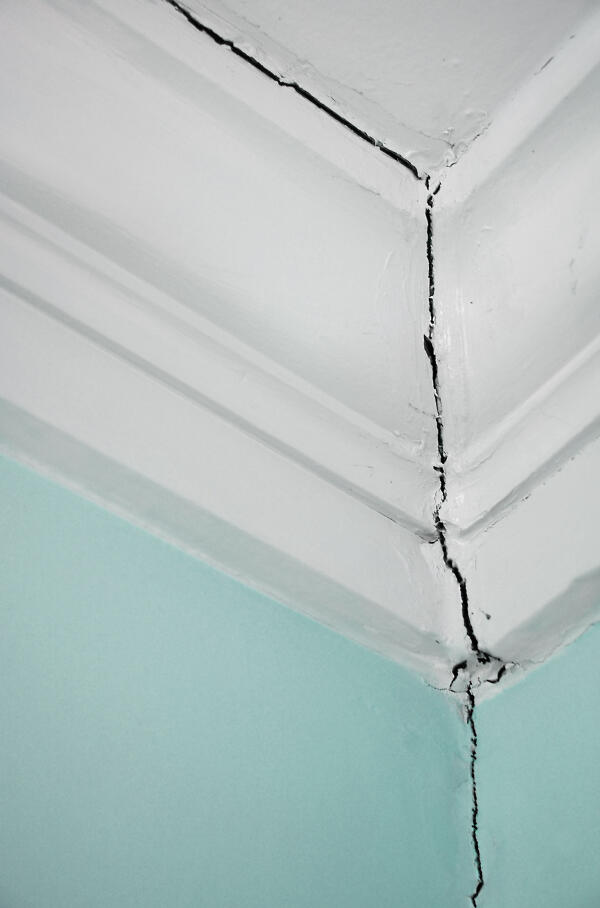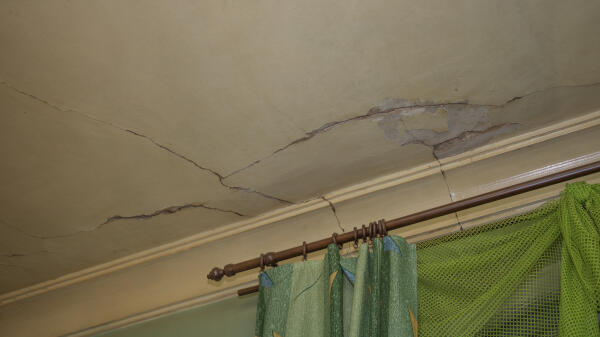Causes Of Ceiling Cracks, And When To Worry
How To Tell If Ceiling Cracks Are Serious
Ceiling cracks may or may not be a sign of structural damage, it truly depends on the crack itself–size, type and location are key factors. At the same time, ceiling cracks’ causes can also include the inevitable settling that buildings experience over time. In general, settling is normal and not necessarily a cause for concern. However, if structural damage may be at the heart of why you’re seeing new ceiling cracks, it’s time to ask a professional to investigate.
Even the best-maintained buildings are vulnerable to damage. Though buildings are stationary, their parts can independently shift and move over time in response to weather, aging materials, and typical wear and tear. Ceiling cracks are a common type of damage that building owners and residents should monitor. When you’re looking at anything other than small, thin cracks, building owners in Cuyahoga County, Geauga County, and Lake County should contact Keystone Home Inspection to assess the situation and provide detailed information and recommendations on how to mitigate further damage. Here’s what you need to know about what causes cracks in ceilings and how to tell if ceiling cracks are serious.
What Causes Ceiling Cracks?
The three most common ceiling cracks causes are: 1) aging buildings, 2) structural damage, and 3) substandard construction. Drywall that is not correctly installed can also cause ceiling cracks. Oftentimes, drywall damage can be easily repaired with reapplications of drywall mud and tape. But as buildings become older, they may face problems such as foundations settling and materials weaking, contributing to more extensive damage.
Moisture damage is one type of structural damage that can lead to ceiling cracks when water travels from the roof or an upper room to settle above the ceiling. When upperstory rooms hold several heavy objects in them, the strain caused by their weight can damage the ceiling of the rooms below them. Ceiling cracks triggered by settling foundations may or may not be an indicator of serious structural problems and should therefore be investigated and potentially treated immediately.

Types Of Ceiling Cracks
Ceiling cracks have different shapes, lengths, and depths. Being able to differentiate between minor cracks and major problems is vital to correctly react to the damage and prevent further complications. Let’s run through the most common types of ceiling cracks you may encounter:
- Small, thin, hairline cracks can be found on a building’s ceiling, walls and even floors. These types of cracks are common due to materials moving and shifting over time. These cosmetic cracks can also be the natural result of temperature and/or humidity fluctuation. It is often a good idea to monitor these cracks, but generally no immediate action is needed and a coat of paint often covers them. If many layers of old paint could be the cause, then sanding and repainting may be a good approach.
- Straight cracks that follow natural joints in the drywall are most often evidence of poor workmanship at the time of drywall installation. The drywall tape was likely not applied correctly or insufficient amounts of plaster were used. This is a cosmetic concern that can be addressed by a drywall contractor.
- Cracks that start on the ceiling and travel down walls are a clear sign of structural damage and should be professionally inspected immediately.
- Ceiling cracks that are paired with sagging are another clear sign of trouble. They need to be looked over by a professional building inspector right away.
- Discolored cracks that appear to be yellow or brown are a definite sign of water damage to your ceiling. Discolored cracks may not directly correspond to existing structural damage, but left unchecked, invading moisture could lead to more serious problems down the road. It is recommended to find a plumbing professional or building contractor to investigate and assess the situation before taking any action.
- Cracks and gaps that exist between walls and ceilings are nearly always the symptoms of either a settling foundation or movement of a building's roof trusses in response to changes in temperature and/or humidity. To ensure safety and stability, it is best to have the home professionally inspected.
- Spiderweb cracks have a center point with radiating cracks, like a spiderweb, and are typically small and not very serious. These may be the result of poor workmanship at installation or natural shifting and settling. On the other hand, larger cracks that display the same kind of formation could be related to a settling foundation and compromised structural integrity. For safety’s sake, it is best to have an inspection done by a professional home inspector.
- Large or deep ceiling cracks can indicate major structural damage and so an inspection is best to be scheduled immediately.
Ceiling Crack Warning Signs
As devastating as severe damage to a building can be, many types of damage not related to immediate disasters or catastrophic circumstances can be easily detected by vigilant residents. Building owners should hire an inspector when they see ceiling cracks that travel down walls, a concentrated mass of small ceiling cracks, or ceiling cracks that are paired with sagging.
Large, deep, and continuous cracks almost certainly point to a structural issue that needs to be addressed by a professional. That said, even small cracks, if in large enough numbers, can indicate an underlying problem that is unsafe. If the ceiling cracks make you uneasy or are paired with other common signs of structural damage, then it is time to schedule a professional building inspection and use the results and recommendations to fix any existing problems. Here are a few signs for building owners and residents to look out for:
- Uneven, sloping or sagging floors
- Sticking doors and windows
- Continuous cracks in flooring
- Cracked or bowed walls
- Shifting in walls
- Cracked or out-of-place moldings
- Stair-step masonry cracks
- Disconnected walls and ceilings/floors
- Separated porches or chimneys
- Water leaking into the basement
Remember, too, that if your local area experienced any natural disasters in recent history, the negative effects of those traumas could be showing up in your building now. It is key to try and locate structural damage and address it before it progresses any further.
Keystone Home Inspection proudly serves building owners in Cleveland. Our inspectors will perform a thorough investigation of your building and provide you with a fully-detailed, easy-to-read report with our findings. To schedule a free phone consultation or an inspection, you can contact us at 216-469-8600, at info@inspectionsbykeystone.com, or on our web page’s contact form.
Contact Us
* - Required Field
Keystone Home Inspection is proud to be a home inspector in the Greater Cleveland, Ohio area including Cuyahoga County, Geauga County, Lake County, Lorain County, Medina County, Portage County, and Summit County.
All Rights Reserved 2025, Keystone Home Inspection - Admin Login | Privacy Policy | Digital Marketing & Social Media Marketing by Alt Media Studios











